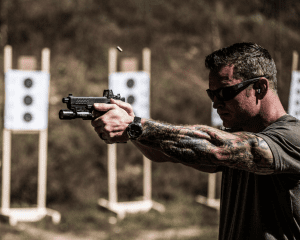How do we properly scan? We’ve all the seen people on the range that keep their eyes in their sights and move their weapon from left to right as a habit. While it looks good and they are checking the block on performing this critical task, sometimes those people aren’t actually identifying anything and are setting themselves up for failure.
If you keep your eyes in your sight while scanning, you are limiting yourself to what is within that toilet paper tube sized housing. With some sights, this is even smaller. As much as we train to go into broad target focus with the sight in line with our eyes, having it there will inevitably pull you back into what’s only visible from that housing. On top of this, red dot is already on your target.
We put our sights on target thousands of times and pull the trigger. Do you think anything will be different when you have to discriminate between a threat and a non-threat? Your brain has been wired to see a red dot or sights on target and pull the trigger. How about when other good guys have a weapon like a police officer responding to a call? Give yourself the time and space necessary to properly identify those around you in an actual situation. By lowering the weapon slightly so that the sights are not immediately visible and on your target, you are creating the amount of time and space necessary for your brain to identify the target, and potentially tell your firing hand not to pull the trigger if needed. I would want that split second extra to determine if what was in the suspect’s hand was a cell phone, an unidentified person holding a badge, or the shape in the middle of the night was actually my wife who accidently tripped over my gym bag while she was checking on the kiddo. There’s a lot of situations that this could be important, I’m sure you can think of several and add it to the comments below.
A good rule of thumb with a rifle is to be able to turn your chin over your buttstock. With a pistol, lower the gun down to your upper chest or break it back enough to be able to see the torso area of those around you. Hands aren’t always above the shoulder line to determine if they have a gun, and badges aren’t always high on the chest to easily see. When you have your weapon pressed out in your line of sight, you are effectively cutting off the majority or the torso that gives us the ability to identify what we need, get a snapshot of the person, and proceed into our “snapshot… hands, aim, shoot” process of target identification.
Scan with your eyes and actually identify the targets to your left and right of your area. ID target, engage until target begins to go down, gun down, eyes lead gun, and snap onto next target if required. Use your eyes to gather information and determine whether or not you will give commands or engage depending on your situation. You can only shoot as fast as you can see, and you can only make decision as fast as you can process information. Don’t limit yourself on either, or set yourself up for failure.
 Drew Estell is the owner of BAER Solutions, and served for a decade in Special Operations. He has been fortunate enough to serve with soldiers and instructors who were invested in his success, and as such have benefited from the years of experience that each of them had. During the course of his multiple combat deployments and experiences, he has learned that no shooter is the same.
Drew Estell is the owner of BAER Solutions, and served for a decade in Special Operations. He has been fortunate enough to serve with soldiers and instructors who were invested in his success, and as such have benefited from the years of experience that each of them had. During the course of his multiple combat deployments and experiences, he has learned that no shooter is the same.
In addition to weapons training classes, BAER Solutions offers leadership and team building consultations. BAER Solutions also works with police departments to take lessons learned from SOF deployments and apply them to the specific needs of the local governance and populace. By combining SOF tenets of Village Stability Operations and the concept of Community Policing, they deliver a consulting and training package called Unconventional Policing.
For more information this topic, create your free account at Greyhive and subscribe to our YouTube channel to watch the pistol ready position videos demonstrating this.
Snapshot is a bi-weekly series from Greyhive featuring content written by our Experts. It is our goal to deliver information that prompts you to examine your preparedness from all angles, not just how quickly and accurately you shoot.
Tags: BAER Solutions, Drew Estell, Greyhive


Good info, this is what I like to see from posts like “Gunfighter moments” and such. Greedy eyes, fast eyes.
Drew is good people. I’ve sat and discussed CQB and Tactical Team work with him, and it was like a 1st year doctor picking the brain of a 20 year neurosurgeon.
This is good stuff, to often do I see students on the range doing their scans and checks just as a matter of fact, bad bad habits. A few tools I’ve utilized to help break this; one can stand behind the student and hold something in their hands or number your fingers, then ask the student upon scan completion toID what was in your hands or the number presented. Also, have drills where upon entering the room or the drill, the student is forced to pickup other threat/non threat targets while scanning and is forced to make that proper UOF decision instead of just going through the motions.